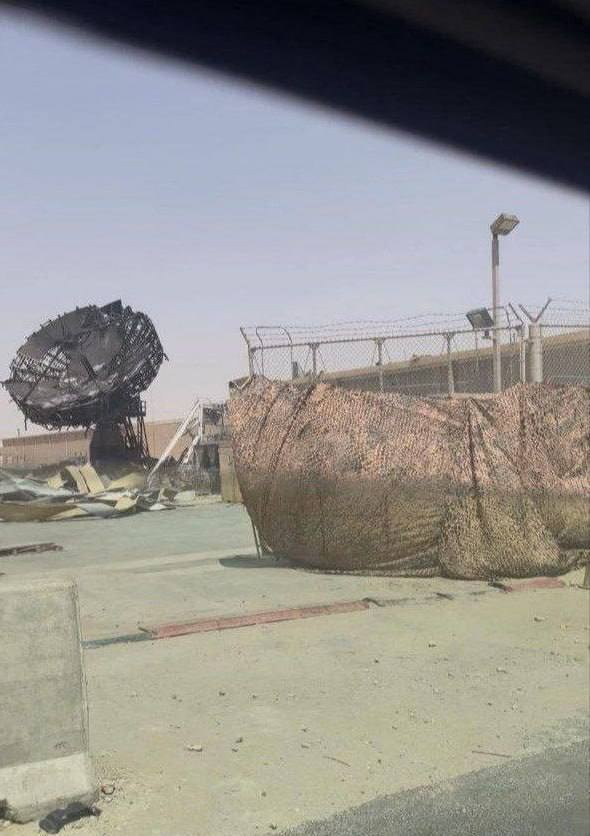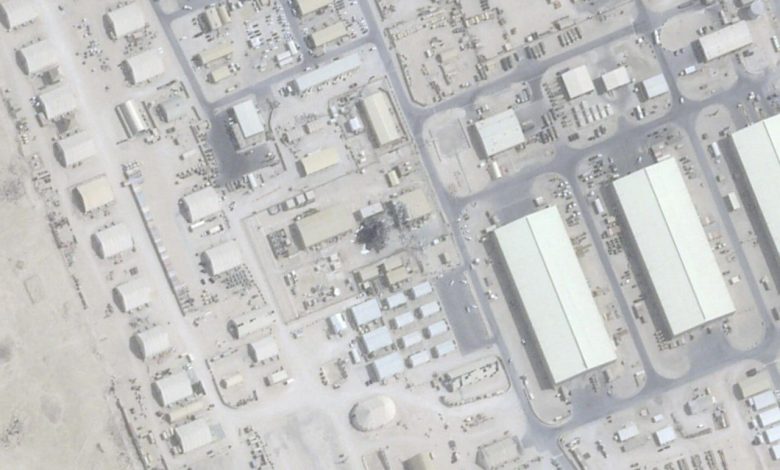Latest Photos Reveal Devastating Radar Damage at US Al-Udeid Base After Iran Strike
What began as carefully worded Pentagon statements about “minimal impact” now lies in stark contrast to high-resolution photos showing that the June 23 strike not only obliterated a USD 15 million (RM 71 million) secure geodesic terminal dome but also severely crippled the base’s critical radar system, which serves as the eyes and ears for American air dominance in the Middle East.
Fresh satellite and ground imagery from the United States’ Al-Udeid Air Base in Qatar has ripped apart official narratives by revealing the devastating accuracy of Iran’s ballistic missile arsenal — a wake-up call for Washington and its regional allies who have long touted the base as an impenetrable fortress.
What began as carefully worded Pentagon statements about “minimal impact” now lies in stark contrast to high-resolution photos showing that the June 23 strike not only obliterated a USD 15 million (RM 71 million) secure geodesic terminal dome but also severely crippled the base’s critical radar system, which serves as the eyes and ears for American air dominance in the Middle East.
Images released by open-source intelligence communities clearly show the radar’s primary dish — a linchpin for threat detection and airspace management — reduced to mangled metal, proof that Iran’s missile barrage achieved the precision Tehran has long claimed but Washington has often dismissed.
Only days before, satellite images by Planet Labs captured the dome’s direct hit, igniting fresh debate among military strategists over the true survivability of static forward bases against modern, highly accurate short- and medium-range ballistic missiles now proliferating across the region.
Al-Udeid has long been more than a dot on the map.
Positioned roughly 35 kilometers southwest of Doha, the base is the largest U.S. military installation in the Middle East, hosting more than 10,000 troops, contractors, and coalition partners.
It boasts twin 12,500-foot runways, hardened aircraft shelters, a subterranean command complex, and the full spectrum of assets — from B-52 and B-1 bombers to KC-135 tankers and MQ-9 Reaper drones — that enable CENTCOM and AFCENT to project airpower from the Gulf to the Eastern Mediterranean.

Yet the events of June 23 underscore a brutal reality: even with layers of Patriot PAC-3 and THAAD systems, American bases are no longer safe havens immune to the region’s evolving missile threat.
The Iranian barrage, carried out in retaliation for U.S. airstrikes on three Iranian nuclear sites just days earlier, shattered the myth that Gulf air defences can intercept and neutralize every incoming threat.
Pentagon spokesperson Sean Parnell sought to downplay the impact, stating: “One Iranian ballistic missile did strike Al-Udeid Air Base on June 23, while the rest were successfully intercepted by U.S. and Qatari air defence systems.”
Parnell further insisted the damage was limited: “Al-Udeid Air Base remains fully operational and fully capable of carrying out its mission alongside our Qatari partners to ensure security and stability across the region.”
CENTCOM commander General Dan Caine described the defensive response as “the single largest Patriot engagement in U.S. military history,” adding that simultaneous launches by both American and Qatari batteries produced “a lot of metal flying around.”
But new images dismantle the official line.
They show the crater where the multi-million-dollar dome once stood, along with the radar dish left in twisted ruin — strong evidence that at least one Fateh-110 or Zolfaghar-class missile penetrated multiple layers of air defence.

For years, Western defence planners have downplayed Iran’s ballistic missile arsenal, dismissing its accuracy as unreliable and its CEP (circular error probable) too wide to pose a precision threat.
But in the last decade, Tehran has poured significant resources into improving range, guidance, and terminal accuracy.
Recent reports suggest CEPs below 10 meters at ranges over 500 kilometers for some systems, transforming Iranian missiles from blunt tools of terror into battlefield game-changers capable of taking out hardened or high-value targets.
Al-Udeid’s vulnerability is not just an isolated anecdote.
It’s an indicator of a shifting regional military balance where static airbases and command nodes — no matter how fortified — can be disabled or degraded with a well-coordinated strike.
For the United States, the operational impact is far from trivial.
Al-Udeid serves as the primary nerve centre for coordinating 24/7 ISR flights, integrated strike missions, air refuelling sorties, and real-time C2 across flashpoints from the Strait of Hormuz to the Arabian Sea.

Any degradation of its secure communications or primary radar system could impose significant friction on U.S. freedom of action at precisely the moment when rapid response and multi-domain integration matter most.
This is especially relevant as CENTCOM continues to recalibrate its footprint after drawdowns in Iraq, Syria, and Afghanistan.
For its Gulf allies — Qatar, Saudi Arabia, the UAE, and Bahrain — the strike rekindles uncomfortable questions about the credibility of the U.S. deterrence umbrella in an era of increasingly sophisticated and survivable missile threats.
If Al-Udeid — touted for years as one of the most heavily defended U.S. bases overseas — can be hit so precisely, what does this imply for other forward bases and critical infrastructure across the Gulf?
How resilient are regional air defences if Iran’s missile salvoes can penetrate layered Patriot and THAAD systems that form the backbone of American and partner nation security architectures?
The implications for force posture are profound.
Already, analysts are debating whether the U.S. should diversify and disperse its assets further, adopt more hardened mobile C2 nodes, and accelerate the integration of advanced counter-missile technologies like directed-energy weapons and rapid-reaction interceptors.
This echoes lessons learned from Ukraine’s battlefield, where high-value static command posts and radar sites have repeatedly been targeted by Russian missile and drone strikes despite layered defences.
For Tehran, the Al-Udeid strike is a propaganda coup.
It sends a powerful signal that Iran retains both the intent and capacity to inflict pain on America’s regional military architecture — a narrative that resonates far beyond the Gulf, feeding into the larger strategic rivalry between Washington and the so-called ‘Axis of Resistance.’
For now, the Pentagon insists the base remains operational.
But the sight of a USD 15 million (RM 71 million) dome and radar lying in ruin is a stark reminder that no fortress is truly impregnable in the face of a determined adversary armed with modern precision-strike weapons.
It also calls into question whether incremental upgrades to existing Patriot and THAAD batteries can keep pace with the evolving missile threat, or whether a deeper rethinking of base design, dispersal, deception, and multi-domain integration is overdue.
Regional militaries are watching closely.
Riyadh, Abu Dhabi, Manama, and Doha have invested billions in American-made missile defence systems.
Yet the evidence from Al-Udeid suggests that a handful of well-aimed missiles can still slip through, disrupting command-and-control functions that are critical in any high-tempo conflict scenario.
In the new era of precision warfare, the lessons from Al-Udeid are clear.
Commanders must assume that static nodes will be targeted.
They must build redundancy, disperse assets, protect key systems with advanced hardening and camouflage, and adopt a mindset where mobility and deception are as vital as iron domes and steel bunkers.
As Washington recalibrates its security guarantees to Gulf partners, the charred wreckage of Al-Udeid’s communications hub may well become a symbol that static dominance is no longer enough to ensure control in a region where precision-strike capabilities are no longer a monopoly of the world’s most advanced militaries.



